Ditapis dengan

INDONESIA ECONOMIC QUARTERLY Maret 2014 ; Investasi yang tak menentu
Ekonomi Indonesia terus menyesuaiakan diri ditandai dengan pelemahan nilai tukar perdagangan (terms of trade) dan pengetatan kondisi pendanaan luar negeri, dengan komposisi pertumbuhan yang lebih di dominasi oleh ekspor bersih diserta dengan pertumbuhan ekonomi yang sedikit melambat. Sementara penyesuaian yang dilakukan bersifat positif bagi stabilitas ekonomi makro, apa yang terus – mene…
- Edisi
- Maret 2014
- ISBN/ISSN
- -
- Deskripsi Fisik
- v, 58 halaman ; 28 cm
- Judul Seri
- Textbook
- No. Panggil
- 330.05 THE i
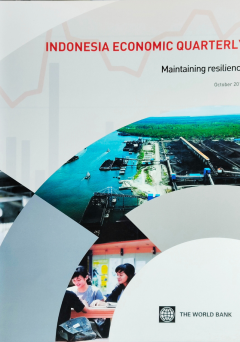
INDONESIA ECONOMIC QUARTERLY October 2012 ; Maintaining resilience
Indonesia’s growth performance has remained robust in the face of global economic weakness but, with risks remaining high, the economy’s resilience to future shocks can be further strengthened through a continued focus on crisis preparedness, on facilitating investment and on improving the quality of public spending.
- Edisi
- Oktober 2012
- ISBN/ISSN
- -
- Deskripsi Fisik
- ix, 44 halaman ; 28 cm
- Judul Seri
- Textbook
- No. Panggil
- 330.05 THE i
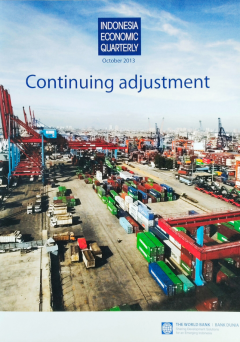
INDONESIA ECONOMIC QUARTERLY October 2013 ; Continuing adjustment
This outlook of a moderate slowdown in growth to just above 5 percent depends on Indonesia avoiding more binding external financing pressures. This depends on global funding conditions remaining sufficiently supportive, and on how well Indonesia’s policies facilitate continued near-term adjustment, and support competitiveness and investment.
- Edisi
- Oktober 2013
- ISBN/ISSN
- -
- Deskripsi Fisik
- iv, 55 halaman ; 28 cm
- Judul Seri
- Textbook
- No. Panggil
- 330.05 THE i
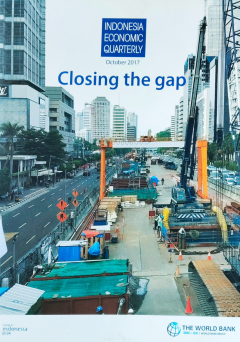
INDONESIA ECONOMIC QUARTERLY October 2017 ; Closing the gap
Private consumption growth unexpectedly remained unchanged in Q2. The steady momentum in private consumption, which accounts for over half of Indonesia’s GDP, stands in contrast to several favorable drivers, such as strong job growth, double-digit wage increases and the shifting of the Idul Fitri festive season to Q2 this year
- Edisi
- Oktober 2017
- ISBN/ISSN
- -
- Deskripsi Fisik
- iv, 63 halaman ; 28 cm
- Judul Seri
- Textbook
- No. Panggil
- 330.05 THE i
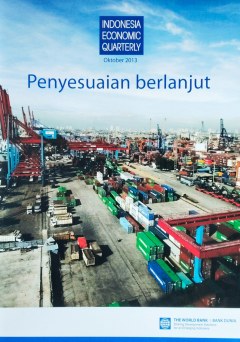
INDONESIA ECONOMIC QUARTERLY Oktober 2013 ; Penyesuaian berlanjut
Perkembangan Triwulanan Perekonomian Indonesia (Indonesia Economic Quarterly/IEQ) mempunyai dua tujuan. Pertama, untuk menyajikan perkembangan utama perekonomian Indonesia dalam tiga bulan terakhir, dan menempatkan dalam konteks jangka panjang dan global. Berdasarkan perkembangan ini, serta perubahan kebijakan dalam periode tersebut, laporan ini menyediakan perkembangan terkini secara rutin ten…
- Edisi
- Oktober 2013
- ISBN/ISSN
- -
- Deskripsi Fisik
- v, 58 halaman ; 28 cm
- Judul Seri
- Textbook
- No. Panggil
- 330.05 THE i
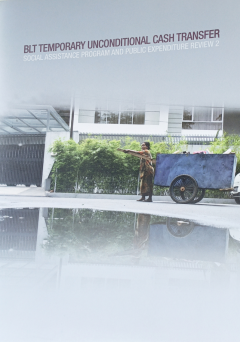
BLT Temporary Unconditional Cash Transfer: Social Assistance Program and Publ…
The Bantuan Langsung Tunai (BLT) program had a clear and modest objective: supplement consumption for poor households facing unprecedented price increases. In 2005 subsidy cuts raised household fuel prices by an average of over 125 percent with 88, 186, and 105 percent increases in gasoline, kerosene, and solar (diesel) fuels respectively. BLT, a direct cash transfer in four installments over o…
- Edisi
- -
- ISBN/ISSN
- -
- Deskripsi Fisik
- 48 halaman
- Judul Seri
- Textbook
- No. Panggil
- 361 WOR b
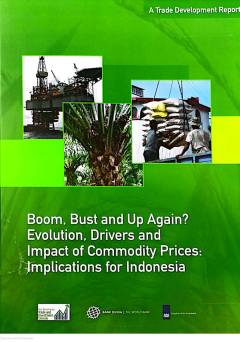
Boom, Bust and Up Again? Evolution, Drivers and Impact of Commodity Prices: I…
This book delves into the intricate dynamics of commodity prices, exploring their evolution, drivers, and consequential impacts, particularly in the context of Indonesia. Through comprehensive analysis and empirical evidence, it examines the cyclical nature of commodity markets, from periods of booming growth to sudden downturns and subsequent recoveries. By identifying key drivers such as glob…
- Edisi
- 1
- ISBN/ISSN
- -
- Deskripsi Fisik
- iii, 266 hal. : il. berwarna ; 30 cm.
- Judul Seri
- Textbook
- No. Panggil
- 330 WOR b
 Karya Umum
Karya Umum  Filsafat
Filsafat  Agama
Agama  Ilmu-ilmu Sosial
Ilmu-ilmu Sosial  Bahasa
Bahasa  Ilmu-ilmu Murni
Ilmu-ilmu Murni  Ilmu-ilmu Terapan
Ilmu-ilmu Terapan  Kesenian, Hiburan, dan Olahraga
Kesenian, Hiburan, dan Olahraga  Kesusastraan
Kesusastraan  Geografi dan Sejarah
Geografi dan Sejarah